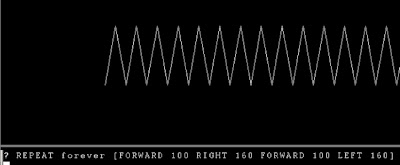1
If Grawlixes represent the execution of an ‘automatic program of actions’ (see previous posts), this implies some underlying repetitive machine-like behavior and it should be relatively easy to write them into executable instructions.
Here are some of the most common Grawlixes written in LOGO(1).
to GRAWLIX
REPEAT forever [RIGHT RANDOM FORWARD RANDOM]
REPEAT forever [RIGHT RANDOM FORWARD RANDOM]
to SAWR
REPEAT forever [FORWARD RIGHT FORWARD LEFT]
to NITTLE
REPEAT forever[FORWARD RIGHT 144]
to SPURL
REPEAT 90[FORWARD 1 RIGHT 2]
REPEAT 36 [FORWARD 1 RIGHT 5]
end
REPEAT forever [SPURL]
to JARN :step :turn
FORWARD :step
RIGHT :turn
JARN :step - 1 :turn
end
[JARN]
What I think these examples show is that most of the times a single line of instruction is enough to produce an Grawlixes, and each seems to be generated by a different iterative or continuous instruction, thus making it credible that they are the result of some fundamental automatic process.
2
If Grawlixes are somatic markers, and represent actions that are actually movements; What then are the movements and actions the different Grawlixes represent?
If we treat the outcome of the instruction as a trace we should be able to reconstruct the action.
- To GRAWLIX; Going and turning randomly all the time.
- To SAWR; Going ahead, sharply turning left and right all the time.
- To NITTLE; Going straight, sharply turning the same amount every time.
- To SPURL; Turning and turning a bit more all the time.
- To JARN; Going forward, turning, and going forward a bit less every time.
We have already established that the face indicates whether the experience is good or bad, and even though such an experience is always subjective and depending on the situation, it should now be possible to give some general description of the underlying feeling by answering the question ‘how is it going?’
And I think it’s reasonable to assume here that any action that repeats forever will have a sense of madness to it.
For example; To GRAWLIX; It’s going anywhere, I have no control!
3
Not every example in the list of Grawlixes seems to be an index for movement.There are also punctuation marks
and symbols (more about these later)
Another way Grawlixes could prove to be automatic besides by how they are produced, is by the way they are uttered, for example when a cartoon character curses.
In his book 'Why We Curse' Timothy Jay(2) identifies two types of cursing, here illustrated with their possible Grawlix versions.
1. Non-propositional cursing that is automatic, reflexive and effortless.
‘Automatic cursing draws heavily on the on the abilities of the right hemisphere.’
An example of automatic cursing is cursing in response to surprise or frustration.
‘Automatic cursing draws heavily on the on the abilities of the right hemisphere.’
An example of automatic cursing is cursing in response to surprise or frustration.
(Franquin, Spirou et Fantasio #15 1961)
2. Propositional cursing that is not reflexive but strategic and creative.
It is effortful because it uses more cognitive resources than automatic cursing.
It draws heavily on the abilities of the left hemisphere and relies on syntax, semantics and logic.
It is effortful because it uses more cognitive resources than automatic cursing.
It draws heavily on the abilities of the left hemisphere and relies on syntax, semantics and logic.
(Goscinny & Uderzo. Asterix and Cleopatra 1965)
So at least some non-objective Grawlixes appear to be generated and expressed by an automatic program of actions and can be combined into complex wholes.
from;
(1) Abelson, H. diSessa, A. Turtle Geometry, ISBN 0-262-51037-5
(2) Jay, Timothy. Why We Curse, ISBN-13: 978-1556197581
Walker, Mort. The Lexicon of Comicana, ISBN 0-595-08902-X









Geen opmerkingen:
Een reactie posten